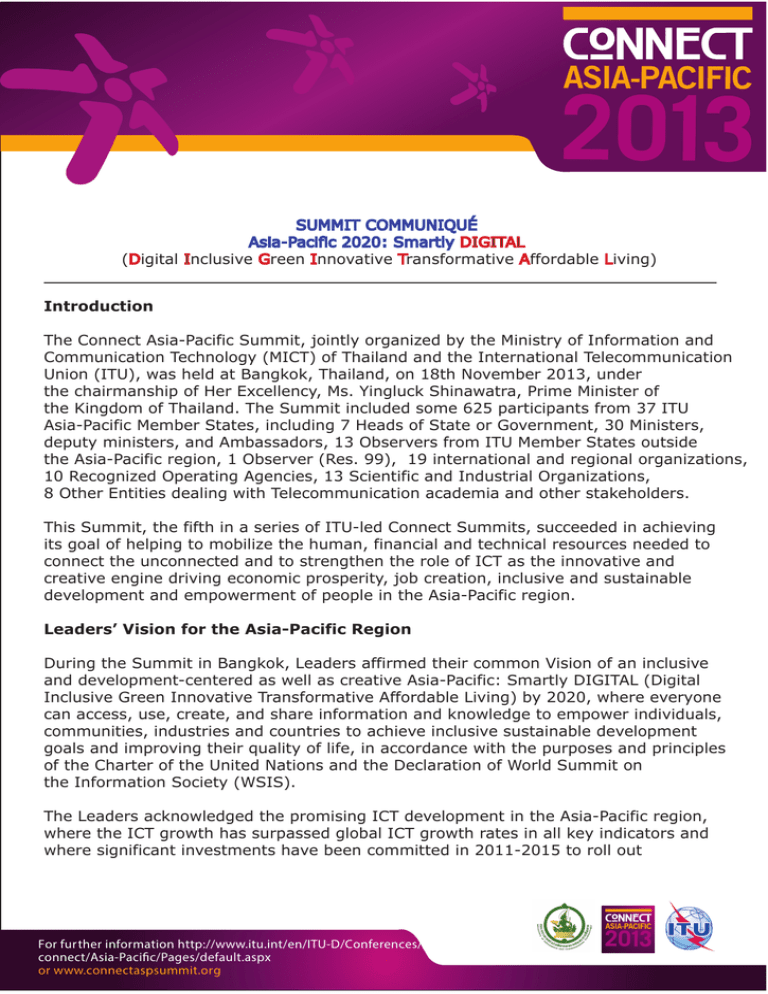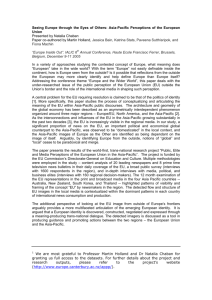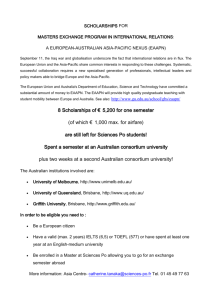SUMMIT COMMUNIQUÉ Asia-Pacific 2020: Smartly DIGITAL
advertisement

SUMMIT COMMUNIQUÉ Asia-Pacific 2020: Smartly DIGITAL (Digital Inclusive Green Innovative Transformative Affordable Living) Introduction The Connect Asia-Pacific Summit, jointly organized by the Ministry of Information and Communication Technology (MICT) of Thailand and the International Telecommunication Union (ITU), was held at Bangkok, Thailand, on 18th November 2013, under the chairmanship of Her Excellency, Ms. Yingluck Shinawatra, Prime Minister of the Kingdom of Thailand. The Summit included some 625 participants from 37 ITU Asia-Pacific Member States, including 7 Heads of State or Government, 30 Ministers, deputy ministers, and Ambassadors, 13 Observers from ITU Member States outside the Asia-Pacific region, 1 Observer (Res. 99), 19 international and regional organizations, 10 Recognized Operating Agencies, 13 Scientific and Industrial Organizations, 8 Other Entities dealing with Telecommunication academia and other stakeholders. This Summit, the fifth in a series of ITU-led Connect Summits, succeeded in achieving its goal of helping to mobilize the human, financial and technical resources needed to connect the unconnected and to strengthen the role of ICT as the innovative and creative engine driving economic prosperity, job creation, inclusive and sustainable development and empowerment of people in the Asia-Pacific region. Leaders’ Vision for the Asia-Pacific Region During the Summit in Bangkok, Leaders affirmed their common Vision of an inclusive and development-centered as well as creative Asia-Pacific: Smartly DIGITAL (Digital Inclusive Green Innovative Transformative Affordable Living) by 2020, where everyone can access, use, create, and share information and knowledge to empower individuals, communities, industries and countries to achieve inclusive sustainable development goals and improving their quality of life, in accordance with the purposes and principles of the Charter of the United Nations and the Declaration of World Summit on the Information Society (WSIS). The Leaders acknowledged the promising ICT development in the Asia-Pacific region, where the ICT growth has surpassed global ICT growth rates in all key indicators and where significant investments have been committed in 2011-2015 to roll out For fur ther information http://www.itu.int/en/ITU-D/Conferences/ connect/Asia-Pacific/Pages/default.aspx or www.connectaspsummit.org broadband infrastructure and applications including innovative public-private partnership. The Summit yet recognized the challenges faced by countries in the Asia-Pacific region having two thirds of the world’s population which, with its unique geographic and demographic circumstances and diversity, has a stark contrast between the region’s high-income and highly advanced countries on the one hand, and the least developed countries (LDCs), landlocked developing countries (LLDCs), and small island developing states (SIDSs) on the other hand. These challenges also offer opportunity of harnessing the immense potential for developing innovative ICT infrastructure and creative ICT applications in order to positively transform lives of people as we move towards reaching the Vision of Asia-Pacific 2020: Smartly DIGITAL. Thus, the focus should be on continued sustainable and inclusive growth in ICT - broadband inter alia through policy leadership and recognition that ICT/broadband is a national priority for the overall socio-economic development as well as a powerful tool or enabler for achieving Millennium Development Goals (MDGs), the post-2015 Development Agenda and the World Summit on the Information Society (WSIS) Declaration and Actions. In doing so, Leaders highlighted in particular, the contribution of the Ministry of Information and Communication Technology (MICT) of Thailand, the International Telecommunication Union as the leading UN agency for ICT, in partnership with the Asia Pacific Telecommunity (APT), the Asia-Pacific Broadcasting Union (ABU), Economic and Social Commission for Asia and the Pacific (ESCAP), UN agencies, development and funding institutes, and other relevant stakeholders in the Asia-Pacific and beyond for joining hands in this historic Connect Asia-Pacific Summit. Priority Areas for Action In determining priority-actions for the Asia-Pacific Region, Leaders renewed their commitment to promote specific measures of solidarity and assistance for Least Developed Countries (LDCs) in the region, with emphasis on Landlocked Developing Countries (LLDCs), the Small Island Developing States (SIDSs) and those countries facing great challenges in realizing the spirit of being Smartly DIGITAL that we aspire for. Leaders also agreed to furthering ICT development in accordance with the regional priorities of the Asia-Pacific, taking into account cultural diversity in the region, and intensifying efforts to achieve Asia-Pacific 2020: Smartly DIGITAL. In order to achieve the Leaders’ Vision for the Asia-Pacific Region the Summit identified following priority areas for action to be carried out in partnership with all relevant stakeholders: 1. 2. 3. 4. 5. 6. Investing in ICT Infrastructure Stimulating Innovation and Creative Use of ICT Encouraging Innovative Public-Private Partnership Promoting Sustainable development through ICT Fostering Digital Inclusion Achieving digital literacy and building human and institutional capacity For further information http://www.itu.int/en/ITU-D/Conferences/ connect/Asia-Pacific/Pages/default.aspx or www.connectaspsummit.org Partnerships for Results While having recognized ITU’s flagship initiatives such as m-Powering Development; Smart Sustainable Development (SSDM); Connect a School, Connect a Community; Connecting Villages; ITU Academy Partnership; and Global Cybersecurity Agenda, the Summit took concrete steps through announcing, signing, awarding and calling partnership projects in such areas as ICT infrastructure development, ICT applications (e.g., e-health, e-security, e-agriculture etc.), innovative and creative use of ICT, digital literacy, human capacity building, broadcasting, emergency telecommunication, digital inclusion amongst others (Publication titled “Projects and Initiatives making a difference in the Asia-Pacific region through ICTs”) through smart partnership among multi-stakeholders in order to realize Smartly DIGITAL Asia-Pacific 2020. All stakeholders at the Summit, including governments, public and private sectors, civil society, UN system, regional and international organizations, and development and funding agencies agreed to work together to achieve these priorities, keeping in mind the diverse needs of the countries in the region with different phases and levels of ICT development and market conditions. To this end, all stakeholders further agreed to work towards suitable and inclusive frameworks and mechanisms at the regional and/or sub-regional levels while allowing sufficient flexibility to tailor approaches at the national and local needs. To demonstrate firm commitment towards achieving the Leaders’ Vision, a number of projects through partnerships valued at USD 53 billion were identified as market opportunities by the relevant partners and stakeholders. Details of these projects can be found at the Publication for Projects at the link www.itu.int/ITU-D/connect/asiapacific/projects.asp, through which proposals for projects will continue to be accepted and added to this database after the Summit. Measuring Progress The Leaders highlighted the importance of following up on the progress made in implementing Summit commitments. In that regard, a follow-up, monitoring, evaluation and information exchange mechanism will be implemented by ITU in collaboration with all partners to track progress as well as identify gaps and avoid overlapping efforts of partners. For further information http://www.itu.int/en/ITU-D/Conferences/ connect/Asia-Pacific/Pages/default.aspx or www.connectaspsummit.org




